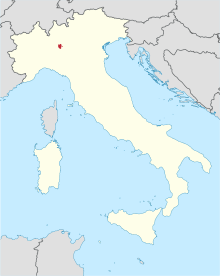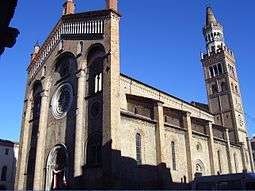Roman Catholic Diocese of Crema
| Diocese of Crema Dioecesis Cremensis | |
|---|---|
|
Crema Cathedral | |
| Location | |
| Country | Italy |
| Ecclesiastical province | Milan |
| Statistics | |
| Area | 276 km2 (107 sq mi) |
| Population - Total - Catholics |
(as of 2013) 103,297 102,000 (est.) (98.7%) |
| Parishes | 62 |
| Information | |
| Denomination | Catholic Church |
| Rite | Roman Rite |
| Established | 11 April 1579 (437 years ago) |
| Cathedral | Cattedrale di S. Maria Assunta |
| Secular priests |
92 (diocesan) 10 (Religious Orders) |
| Current leadership | |
| Pope | Francis |
| Bishop | Sede Vacante |
| Map | |
 | |
| Website | |
| www.diocesidicrema.it | |
The Diocese of Crema (Latin: Dioecesis Cremensis) is a Roman Catholic ecclesiastical territory in northern Italy, existing since 1579. It is suffragan to the Archdiocese of Milan.[1][2] Its seat is Crema Cathedral.
History
Founded in the sixth century, Crema endured a particularly hazardous geographical position in terms of its independence.[3] It was no great distance from Milan, and its neighbor to the east, the Serene Republic of Venice, was always pressing to expand its holdings on the mainland. In addition the German emperors held the overlordship of the Po Valley and from time to time dominated the political situation.[4] Otto of Freising (died 1158), for instance, draws attention to Crema's situation in the perpetual struggle between Cremona and Milan. Crema was situated just half way between Cremona and Milan. It bore a good deal of the military action, and, as Cremona regularly rejected its demands in litigation for redress and reparations, Crema developed a grudge. This was particularly wrenching since Crema was politically subject to Cremona and spiritually subject to its bishop. To gain an advantage, the leaders of Cremona urged the Emperor Frederic Barbarossa to destroy Crema in exchange for a considerable sum of money, which would allow him to pursue his ventures in the Po Valley. The citizens of Crema therefore threw in their lot with Milan.[5]
Crema became subject to the Republic of Venice in September 1512, and the possession was ratified by the Treaty of Blois of 1513.[6] The diocese of Crema was created by splitting off territory that had been part of the Diocese of Lodi. of Cremona and of Piacenza.[7]
Bishops of Crema
1580 to 1800
- (1580–1584) : Girolamo Diedo[8]
- (1584-1616) : Gian Giacomo Diedo[9]
- (1616-1629) : Pietro Emo, C.R.[10]
- (1629-1633) : Marcantonio Bragadin[11]
- (1633-1677) : Alberto Badoer[12]
- (1678-1702) : Marcantonio Zollio[13]
- (1702-1730) : Faustino Giuseppe Griffoni Sant’Angelo[14]
- (1730-1751) : Ludovico Calini[15]
- (1751-1781) : Marco Antonio Lombardi[16]
- (1782-1800) : Antonio Maria Gardini, O.S.B.[17]
since 1800
- Tommaso Ronna (1807–1828)[18]
- Carlo Giuseppe Sanguettola (1835–1854)[19]
- Pietro Maria Ferré (1857-1859)[20]
- Carlo Macchi (1859–1867)[21]
- (1871-1893) : Francesco Sabbia[22]
- Bernardo Pizzorno (1911-1915)
- Carlo Dalmazio Minoretti (1915-1925)[23]
- Giacomo Montanelli (1925-1928)[24]
- Marcello Mimmi (1930-1933)[25]
- Francesco Maria Franco (1933-1950)
- Giuseppe Piazzi (1950-1953)[26]
- Placido Maria Cambiaghi, B. (1953-1963)[27]
- Franco Costa (1963)
- Carlo Manziana, C.O. (1963-1981)
- Libero Tresoldi (1981-1996)
- Angelo Paravisi (1996-2004 Died)
- Oscar Cantoni (2005-2016)[28]
Parishes
The 62 parishes of the diocese are all located in the Province of Cremona, Lombardy.[29] In 2013 in the diocese of Crema there was one priest for every 1,000 Catholics.
References
- ↑ "Diocese of Crema" Catholic-Hierarchy.org. David M. Cheney. Retrieved October 7, 2016
- ↑ "Diocese of Crema" GCatholic.org. Gabriel Chow. Retrieved October 7, 2016
- ↑ Sforza Benvenuti, I, p. 8.
- ↑ Solera, p. 8.
- ↑ Otto of Freising, Gesta Friderici Imperatoris Book IV, chapter 39, in: Monumenta Germaniae Historica Tomus XX, (Hannover 1868), p. 466.
- ↑ M. E. Mallett; J. R. Hale (23 November 2006). The Military Organisation of a Renaissance State: Venice C.1400 to 1617. Cambridge University Press. pp. 222–223. ISBN 978-0-521-03247-6.
- ↑ Solera, p. 9.
- ↑ Diedo was a native of Venice, and the nephew of the Patriarch of Venice, Vincenzo Diedo. Gian Giacomo was appointed Bishop of Crema by Pope Gregory XIII on 20 November 1580. He took possession on 19 May 1581, and resigned the office in favor of his nephew on 28 May 1584. He died in 1585 at the age of sixty-three. Solera, pp. 35-37.
- ↑ Gian Giacomo Diedo attended the University of Padua, taking his degree in 1573. He had been Primicerius of the Cathedral of Padua, and served as Vicar General of his uncle in Crema. On 14 January 1585, he consecrated the new cathedral of Crema. He died on 6 June 1616 at the age of seventy-two, after thirty-two years as bishop. Solera, pp. 45-48.
- ↑ A native of Venice and a learned theologian, Emo had already been titular bishop of Larissa (from 1612) and was appointed Coadjutor with the right of succession to Bishop Diedo. Solera, pp. 53-55. Gauchat, IV, p. 145; p. 216.
- ↑ Bragadin was a native of Venice, and had been Referendary of the Two Signatures in the Roman Curia, when he was appointed Bishop of Crema by Pope Urban VIII on 5 December 1629. He was consecrated in Rome by Cardinal Antonio Barberini on 21 December 1629. He took possession of his See on 17 May 1630. He was appointed Bishop of Ceneda (1633), and then Vicenza (1639). On 16 December 1641 he was named a Cardinal. He died in 1658. Solera, pp. 58-59. Gauchat, IV, pp. 145 and 167.
- ↑ Badoer, a Venetian nobleman, was appointed by Pope Urban VIII on 26 February 1633. He was particularly interested in saving prostitutes; in 1647 he established the church of S. Maria Maddelena for their use. He held a diocesan synod in 1650. Solera, pp. 61-64. Gauchat, IV, p. 145
- ↑ A native of Bergamo, Zollio was a Doctor in utroque iure (Civil Law and Canon Law), and served as sommistore of the Inquisition. On 18 July 1678 he was appointed by Pope Innocent XI, but he did not take possession until May 1684, due to a dispute between the Pope and the Serene Republic of Venice. In 1688 Bishop Zollio held a diocesan synod. Solera, pp. 66-69. Ritzler, V, p. 175 with note 3.
- ↑ Griffoni was a native of the diocese, and belonged to the family of the Conti Sant'Angelo. He was the Vicar General of Bishop Zollio. He was consecrated in Rome on 1 October 1702. He held a diocesan synod in 1727. Solera, pp. 71-76. Ritzler, V, p. 175 with note 4.
- ↑ Calini was born in Calino in the diocese of Brescia. He was Doctor in utroque iure (Civil Law and Canon Law), and Prebendary of the Cathedral of Brescia. He was Synodal Examiner of the diocese. Appointed to the diocese of Crema on 11 September 1730, Calini was consecrated in Rome on 21 September 1730 by Cardinal Angelo Maria Quirini. He resigned on 27 January 1751, and was named titular Archbishop of Antioch on 1 February. Ritzler, VI, p. 186 with note 2.
- ↑ Born in Verona, Lombardi received a doctorate in utroque iure from the University of Mantua (1746). He was consecrated a bishop in Rome on 21 March 1751 by Cardinal Carlo Rezzonico. Ritzler, VI, p. 186 with note 3.
- ↑ Gardini was a native of Venice. He joined the Benedictine community of San Michele de Murano. He was appointed theologian of the Bishop of Torcella in 1769 and lectured in houses of his order. He was Consultor of the Inquisition of Venice for twelve years. He was named to the diocese of Crema on 23 September 1782, and consecrated in Rome on 29 September by Cardinal Carlo Rezzonico the Younger. Ritzler, VI, p. 186 with note 4.
- ↑ Ronna had been a Canon, and then Provost of San Babila in Crema. Gams, p. 789.
- ↑ Sanguettola had been Provost of Santo Stefano in Milan. Gams, p. 789.
- ↑ Ferré had previously been Canon-Archpriest of the Cathedral. He was transferred to Pavia (1859–1867); from Pavia he was transferred to Casale. Gams, pp. 789, 801. Cappelletti, XII, p. 260.
- ↑ Macchi was transferred to Reggio. Gams, p. 789.
- ↑ Giuseppe Pecora (1944). Mons. Francesco Sabbia vescovo di Crema: cenni biografici (in Italian). Milan: Gasparini.
- ↑ Minoretti was then appointed Archbishop of Genoa. He was named a cardinal on 16 December 1929 by Pope Pius XI.
- ↑ Montanelli was then appointed Coadjutor Archbishop of Vercelli
- ↑ Mimmi was then appointed Archbishop of Bari. He was named a cardinal by Pope Pius XII on January 1953.
- ↑ Piazzi was then appointed Bishop of Bergamo.
- ↑ Cambiaghi was then appointed Bishop of Novara.
- ↑ Cantoni was appointed Bishop of Como on 4 October 2016. Diocese of Como, Appointment Announcement of Bishop Cantoni, retrieved: 2016-11-06.
- ↑ Source for parishes: CCI (2008), Parrocchie, Chiesa Cattolica Italiana, retrieved 2008-03-13.
Bibliography
- Barbieri, Luigi Compendio cronologico della storia di Crema (Crema, 1888)
- Cappelletti, Le chiese d'Italia (Venice, 1857), XII, 241-75
- Eubel, Conradus (ed.) (1913). Hierarchia catholica, Tomus 1 (second ed.). Münster: Libreria Regensbergiana. (in Latin)
- Eubel, Conradus (ed.) (1914). Hierarchia catholica, Tomus 2 (second ed.). Münster: Libreria Regensbergiana.
- Eubel, Conradus (ed.); Gulik, Guilelmus (1923). Hierarchia catholica, Tomus 3 (second ed.). Münster: Libreria Regensbergiana.
- Gams, Pius Bonifatius (1873). Series episcoporum Ecclesiae catholicae: quotquot innotuerunt a beato Petro apostolo (in Latin). Ratisbon: Typis et Sumptibus Georgii Josephi Manz.
- Gauchat, Patritius (Patrice) (1935). Hierarchia catholica IV (1592-1667). Münster: Libraria Regensbergiana. Retrieved 2016-07-06.
- Lasagni, Ilaria (2008). Chiese, conventi e monasteri in Crema e nel suo territorio dall'inizio del dominio veneto alla fondazione della diocesi: repertorio di enti ecclesiastici tra XV e XVI secolo (in Italian). Milano: UNICOPLI.
- Ritzler, Remigius; Sefrin, Pirminus (1952). Hierarchia catholica medii et recentis aevi V (1667-1730). Patavii: Messagero di S. Antonio. Retrieved 2016-07-06.
- Ritzler, Remigius; Sefrin, Pirminus (1958). Hierarchia catholica medii et recentis aevi VI (1730-1799). Patavii: Messagero di S. Antonio. Retrieved 2016-07-06.
- Sforza Benvenuti, Francesco (1859). Storia di Crema. Volume primo, Volume secondo. Milano: tipi di G. Bernardoni di Gio.
- Solera, Giovanni (1857). Serie dei Vescovi di Crema, con notizie sulla erezione del Vescovado (in Italian). Milano: Antonio Ronchetti.
- Zaccaria, Francisco Antonio (1763). Cremenensium episcoporum series a Ferdinando Ughellio primum contexta, deinde a Nicolao Coleto paululum aucta, nunc a Francisco Antonio Zaccaria S. J. ... illustrata, emendata atque in hunc diem perducta (in Latin). Brescia: Rizzardi.
External links
- Benigni, Umberto. "Diocese of Crema." The Catholic Encyclopedia. Vol. 4. New York: Robert Appleton Company, 1908. Retrieved: 2016-10-10.
acknowledgment
![]() This article incorporates text from a publication now in the public domain: Herbermann, Charles, ed. (1913). "Diocese of Crema". Catholic Encyclopedia. New York: Robert Appleton.
This article incorporates text from a publication now in the public domain: Herbermann, Charles, ed. (1913). "Diocese of Crema". Catholic Encyclopedia. New York: Robert Appleton.
Coordinates: 45°22′00″N 9°41′00″E / 45.3667°N 9.6833°E
